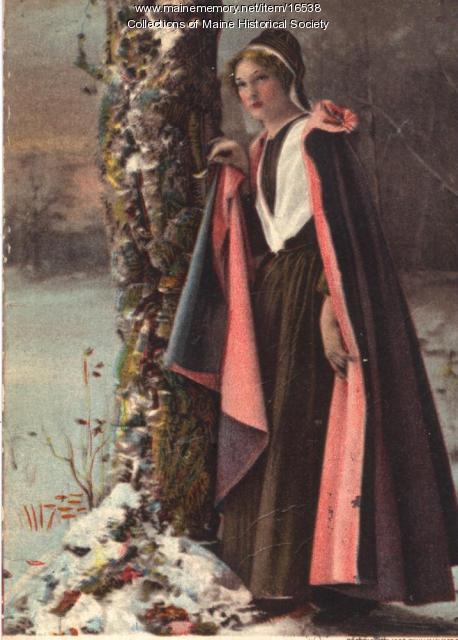Keywords: Reading
Item 19158
Mount Desert Reading Room, ca. 1910
Contributed by: Jesup Memorial Library Date: circa 1910 Location: Bar Harbor Media: Postcard
Item 75142
Reading room at Eastern Fine, Brewer, 1919
Contributed by: Maine Folklife Center, Univ. of Maine Date: 1919-05-03 Location: Brewer Media: Photographic print
Item 67857
16 Ocean Avenue, Portland, 1924
Owner in 1924: Anna E.P. Read Use: Apartments
Item 32992
24-26 Manners Avenue, Portland, 1924
Owner in 1924: Estate of Florence J. Read & H.R. Read Use: Bungalow
Item 150150
Dr. Seth H. Read residence bathroom addition, Belfast, 1947
Contributed by: Maine Historical Society Date: 1947 Location: Belfast Client: Seth H. Read Architect: Eaton W. Tarbell
Item 151580
Winthrop Library, Winthrop, 1916
Contributed by: Maine Historical Society Date: 1916 Location: Winthrop Client: unknown Architect: John Calvin Stevens and John Howard Stevens Architects
Exhibit
Bookplates Honor Annie Louise Cary
A summer resident of Wayne collected more than 3,000 bookplates to honor Maine native and noted opera singer Annie Louise Cary and to support the Cary Memorial Library.
Exhibit
Reading, Writing and 'Rithmetic: Brooklin Schools
When Brooklin, located on the Blue Hill Peninsula, was incorporated in 1849, there were ten school districts and nine one-room school houses. As the years went by, population changes affected the location and number of schools in the area. State requirements began to determine ways that student's education would be handled. Regardless, education of the Brooklin students always remained a high priority for the town.
Site Page
Beyond Borders - Mapping Maine and the Northeast Boundary - Further Reading
"Further Reading Akagi, Roy Hidemichi. The Town Proprietors of the New England Colonies: A Study of Their Development, Organization, Activities and…"
Site Page
Strong, a Mussul Unsquit village - Welcome to Strong
"… Readstown, for the settlement proprietor, William Read. Incorporated as a town in 1801, it was named Strong, for Gov. Caleb Strong of Massachusetts."
Story
Documenting Portland's Neighborhood Bars
by David Read
Peanut House, Sportsman's Grill and a proposal to document Portland's Neighborhood Bars
Story
Stories from Eastport
by Ruth McInnis
My memories of growing up in Eastport, WWII, camping, and history on the border
Lesson Plan
Longfellow Studies: The Acadian Diaspora - Reading "Evangeline" as a Feminist and Metaphoric Text
Grade Level: 6-8, 9-12
Content Area: English Language Arts, Social Studies
Evangeline, Longfellow's heroine, has long been read as a search for Evangeline's long-lost love, Gabrielle--separated by the British in 1755 at the time of the Grand Derangement, the Acadian Diaspora. The couple comes to find each other late in life and the story ends. Or does it?
Why does Longfellow choose to tell the story of this cultural group with a woman as the protagonist who is a member of a minority culture the Acadians? Does this say something about Longfellow's ability for understanding the misfortunes of others?
Who is Evangeline searching for? Is it Gabriel, or her long-lost land of Acadia? Does the couple represent that which is lost to them, the land of their birth and rebirth? These are some of the thoughts and ideas which permeate Longfellow's text, Evangeline, beyond the tale of two lovers lost to one another. As the documentary, Evangeline's Quest (see below) states: "The Acadians, the only people to celebrate their defeat." They, as a cultural group, are found in the poem and their story is told.
Lesson Plan
Longfellow Studies: The Writer's Hour - "Footprints on the Sands of Time"
Grade Level: 3-5
Content Area: English Language Arts, Social Studies
These lessons will introduce the world-famous American writer and a selection of his work with a compelling historical fiction theme. Students take up the quest: Who was HWL and did his poetry leave footprints on the sands of time? They will "tour" his Cambridge home through young eyes, listen, and discuss poems from a writers viewpoint, and create their own poems inspired by Longfellow's works. The interdisciplinary approach utilizes critical thinking skills, living history, technology integration, maps, photos, books, and peer collaboration.
The mission is to get students keenly interested in what makes a great writer by using Longfellow as a historic role model. The lessons are designed for students at varying reading levels. Slow learners engage in living history with Alices fascinating search through the historic Craigie house, while gifted and talented students may dramatize the virtual tour as a monologue. Constant discovery and exciting presentations keep the magic in lessons. Remember that, "the youthful mind must be interested in order to be instructed." Students will build strong writing skills encouraging them to leave their own "footprints on the sands of time."





















